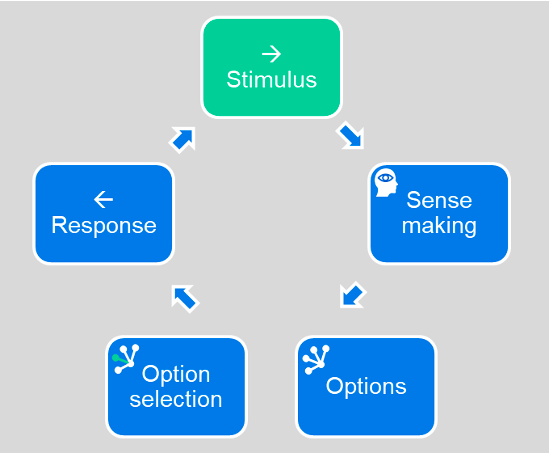Every 50 to 60 years, a paradigm shift occurs that affects the social, business, and economic order. The digital age is ushering in a new one.
Carlota Perez's book Technology Revolutions and Financial Capital links major technology developments with financial cycles. As she describes it, a phase typically starts when new technologies and financial capital begin to create a new way of doing things, as occurred during the Industrial Revolution, the dawn of the railways, and other eras.
A few decades after the paradigm shift, there comes a point at which companies either master the new paradigm or decline. Finally, a deployment period starts, when new technology giants take over the old economy.
This transformation cycle has completely changed the methods required to be successful—what got you here won't get you there. IT leaders who do not understand this will lose relevance in the new age. They will be working harder and harder without hope for success.
So how do you succeed as an IT leader during this latest transition period? You need to learn how to make sense of the challenges, and you need to understand your options, how to make a good choice—and respond. Here's how to make the journey.
The new culture
In the previous age, workers were seen as a cog in a machine, easily interchangeable, performing repeated, easily learnable steps. But in the digital age, high levels of collaboration are essential. Successful teams act more like an adapting organism, using their collective brain power to face ever-faster, more complex solutions and changing demands in a less predictable environment.
To create and maintain a highly motivated, skilled, and engaged workforce that can master the challenges of the digital age, you need to adopt a new leadership style, and develop a culture that supports faster learning and information flow.
The Westrum organizational cultural model, which describes three types of organizational cultures and their effect on information flow, shows the way forward. The digital age demands what Ron Westrum calls generative culture, with the attributes described below.
Figure 1: Organizational culture model. Source: Abstracted from Ron Westrum's book. Infographic created by Peter Vollmer.
Your culture defines how fast your organization can sense market changes and react to them. You need a culture that is continuously improving information flow within and across your company's value streams. In other words, business agility can only grow in a generative culture.
The stimulus-response model
Relationships and collaboration are often based on unconscious behavior. Instead of building trust and motivating others, IT leaders may unintentionally achieve the opposite.
As a consequence, you may fail to build the desired generative culture to help the organization thrive in the digital age. The reason for that is that people run most of the time on autopilot. To get out of this rut, shift more of your actions into conscious decisions and learn and internalize positive behavior patterns.
To be a better leader, you must break this automatism. If you want to help others to grow and be motivated, you must constantly improve your ability to respond according to your intentions.
Between stimulus and response there is space.
In that space is our power to choose our response.
In our response lies our growth and our freedom.
—Viktor Frankl/Stephen Covey
The stimulus-response model that I created is based on Stephen Covey's model. It describes the steps between the initial stimulus and your response, and how you can learn and develop your "response-abilities." It all starts with a stimulus, which could be a conversation, a problem to solve, or a decision to be made.
Here are the steps to take before you respond.
Figure 2: The stimulus-response model. Source: Peter Vollmer
1. Make sense of the situation
First, understand the situation. Sense-making is very subjective and depends on many different factors, such as your mindset, emotional competence, mood or feelings, and relationship to involved people, experience, and culture.
In the context of teams, it is the ability to openly consider the potentially different perspectives and agreeing on the most likely one.
“We actually almost never find a world—we almost always construct it.”
—Michael Hamman
Science shows us that the process of sense-making is usually not an analytical one but one where the brain validates a predefined bias against sense making. We often only see what we know or filter out things that seem irrelevant.
Sense-making can be difficult. Being too confident about your perspective can destroy trust and relationships, leading to a low-performing team or organization. Listen carefully to others and their perspectives. In your team consider an equal share of voice.
2. Understand your options
The options you have depend on your solution space. To a hammer, everything looks like a nail. The size depends on your mindset, knowledge, experience, and ability to include or leverage knowledge from others. That makes listening, insatiable learning, decentralized decision making, and collaboration a daily necessity.
In the IT domain, the right mindset, values and principles are essential for success. Unfortunately, many leaders still operate with the leadership knowledge they gained decades ago. An upgrade to your leadership operating system should include an understanding of:
- Lean-agile mindset, values and principles, including systems thinking, value streams, team topologies, flow, and short feedback cycles
- A growth mindset versus fixed mindset
- Game theory with finite and infinite games
- How to motivate people
- Complexity theory and how to apply it, e.g., as described in the Cynefin model
- A win-win versus win-lose mindset
3. Select the best option
A large solution space is useless if you are not able to select the best option, or at least a good one. Intentionally selecting the right option requires self-awareness, self-regulation, the right mindset, and a clear intention.
Think about the motive behind your option selection:
Figure 3: Does your selected option help to create the right culture? Source: Peter Vollmer
Sometimes it takes courage and vulnerability to select the right option. Sometimes you act based on your priorities. No matter what you do, it should be a conscious decision based on your intentions.
4. Decide on your response
It's not just what you say but also the way you say it. How well can you express yourself? Are you and what you say authentic? People do not like to be manipulated; sooner or later they understand the difference.
What is your relationship with the person or group? Have you developed a trusted relationship? How would you receive such a response? Is it the right timing? How you answer these questions depends on how well you've developed your emotional competence.
Trust, or feeling safe when vulnerable, is key to building high-performing teams. Companies with high levels of trust have 74% less stress, 40% less burnout, 50% higher productivity, and 29% more life satisfaction, according to Paul J. Zak in his 2017 Harvard Business Review article.
In his book The Five Dysfunctions of a Team, Patrick Lencioni points out that without trust you'll have fear of conflict, which leads to lack of commitment, avoidance of accountability, and inattention to results. Building trust is fundamental to an effective team or organization, and it is the IT leader's duty to build that trusted environment.
Get ready to lead
We live in times of disruption and change. Survival demands a new leadership style, and business agility grows best in a generative culture.
You can use the stimulus-response model, as you build your emotional competence and team trust, help to create a successful organizational culture. It is your responsibility as an IT leader to learn how to create this kind of environment to make your people successful.
Keep learning
Get up to speed on digital transformation with TechBeacon's Guide.
Download this free IDC white paper, "Enabling End-to-End Digital Transformation".
See IDC's Futurescape: Top 10 predictions for digital transformation.
How important is digital transformation to your org? Take our survey and find out how you stand next to the competition.
Thinking of making a change? TechBeacon's Careers Topic Center provides expert advice to prepare you your next career move.





